Let's examine notable competitors and Pipefy alternatives, specifically those offering secure access management solutions, to provide valuable options for consideration in enhancing IT processes.
While Pipefy offers a robust platform for process management, it might not always meet the specific needs of every organization. You may find limitations in customization, integration capabilities, or scalability that hinder your team's productivity and workflow optimization. These constraints can lead to bottlenecks, reduced efficiency, and frustration among your team members, ultimately impacting the overall performance of your IT operations.
Recognizing these challenges, it's essential to explore Pipefy alternatives that can better align with your organization's unique requirements. By considering other options, you can find a workflow management tool that offers greater flexibility, enhanced integration with your existing systems, and scalability to support your growing needs.
In this article, we will explore some top alternatives to Pipefy that can help you overcome these pain points. We'll highlight their key features, benefits, and how they compare to Pipefy, enabling you to make an informed decision that best suits your organization's workflow management needs.
But before that let’s discuss the limitations of Pipefy in detail.
Drawbacks of Pipefy “Business Process Automation”
Here are a few drawbacks of Pipefy business process automation:
- Reporting Limitations: Pipefy's reporting capabilities might not meet expectations, restricting visibility into workflows and impeding effective assessment for organizational improvement.
- Cost Considerations: For those seeking budget-friendly options, Pipefy's pricing structure, which is tied to the number of automations, may not align with financial constraints.
- Slow Integration Process: Connecting with existing systems through Pipefy might be slow. This delay can impact the timely automation of workflows, particularly in simplifying repetitive tasks like onboarding and offboarding.
- Dependency on Internet Connectivity: Since Pipefy is a cloud-based solution, its effectiveness may be compromised in scenarios with poor or unreliable internet connectivity, affecting the continuity of operations.
- Security and Compliance Concerns: Organizations operating in highly regulated industries might encounter challenges ensuring compliance or addressing specific security requirements through Pipefy's automation framework.
Therefore, considering an alternative solution is always suitable to ensure you get the best automation solution for your IT teams.
This article will help you explore Pipefy alternatives for business process automation, highlighting their key features, benefits, pros, and cons to assist you in making an informed decision. Let's check out the various Pipefy alternatives to consider:
The 11 Best Pipefy Alternatives for IT Process Automation
Below are some of the best Pipefy alternatives you can consider while your team is looking to optimize business process management.
1. Zluri - Best Alternative to Pipefy
Zluri presents an intelligent User Lifecycle Management (ULM) platform meticulously crafted to empower your IT teams to oversee user access efficiently throughout their entire journey within your organization.
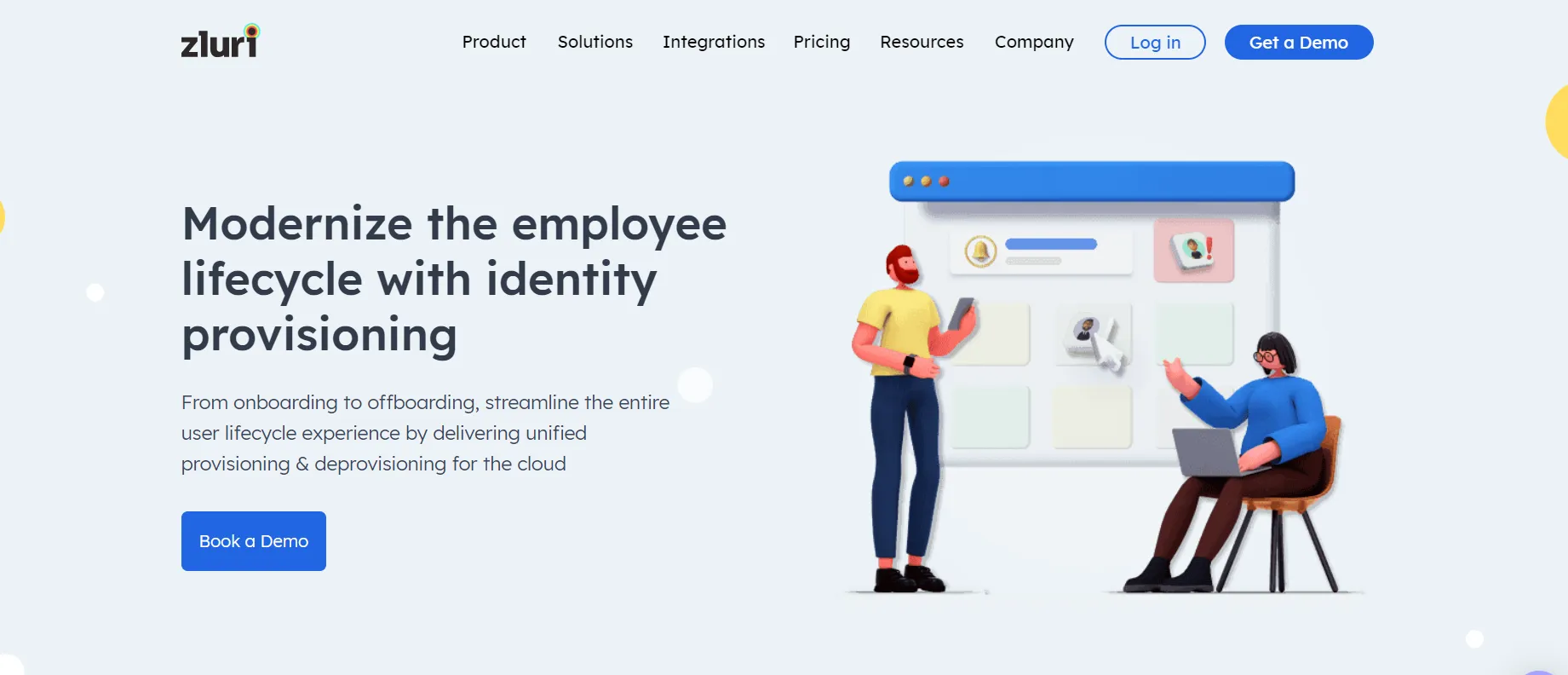
By automating diverse IT functions, it significantly reduces the time and resources your team dedicates to these tasks. Zluri's capabilities encompass streamlining crucial processes such as employee onboarding and offboarding, alleviating these operations' burdensome and time-consuming nature.
A standout feature of Zluri lies in its integration with leading HRMS platforms such as Workday or BambooHR. This integration ensures a seamless flow of information: whenever a new employee joins or departs from your company, Zluri autonomously updates a centralized dashboard, readily accessible to your IT teams.
This intuitive dashboard becomes a repository of essential details, facilitating swift and precise decisions regarding allocating or revocating employee access to resources and systems.
Let’s see how Zluri automates the workflows:
- Automating onboarding workflow
Zluri facilitates streamlined IT operations by enabling automated provisioning, simplifying access for employees. This platform allows your IT teams to grant necessary permissions and software to new hires swiftly. By leveraging Zluri, employees can promptly commence their roles with access to essential applications, bypassing prolonged wait times.
To achieve this seamless onboarding, your IT team can implement an efficient workflow through these steps:
Step 1: To create an onboarding workflow with Zluri, go to “workflow module,” select “onboarding” from the drop-down menu, and simply click on "new workflow."

Step 2: Your team can select one or multiple business users for the process, depending on the needs.

Step 3: Zluri’s "recommendation app" comes in handy. It takes into account the employee's role, designation, and position to suggest the relevant applications they should have access to.

Step 4: Your IT team receives helpful "in-app suggestions." These suggestions guide you on specific actions to take, such as sending invites to particular channels.

Step 5: Adding actions is easy too. Click "Edit Action," enter the required information, and save the task. Your team can even schedule actions to execute management workflow on the onboarding day.
If you want to add more actions, click "Add an action," choose from the available options, provide the necessary details, and save the task.

Note: Also, your team can customize these actions and provide any necessary details. Additionally, they can schedule these actions on the employee's onboarding day, ensuring a smooth and organized process.
Step 6: Finally, your team can simply click on "run" or save the workflow by clicking on "save as playbook" for future use. This makes it easier to replicate the onboarding process whenever needed.

In addition, your IT admin can establish triggers, conditions, and actions in the "automation rule" tab. This enables the automatic granting of Slack access to new hires based on the triggers you define.

But Zluri goes further to improve employee experience and eliminate manual ticketing systems. Let’s see how.
- Streamlining Approval Workflows with Zluri's Employee App Store
Zluri makes life easier for your IT team when it comes to handling employee requests during important changes like promotions or role transitions. Using Zluri's efficient solution, you can eliminate the need for manual ticketing systems.
Introducing the "Employee App Store" by Zluri–a self-serve model that offers convenience and flexibility. Your IT admin can select pre-approved and verified SaaS applications, giving employees a clear overview of their choices.
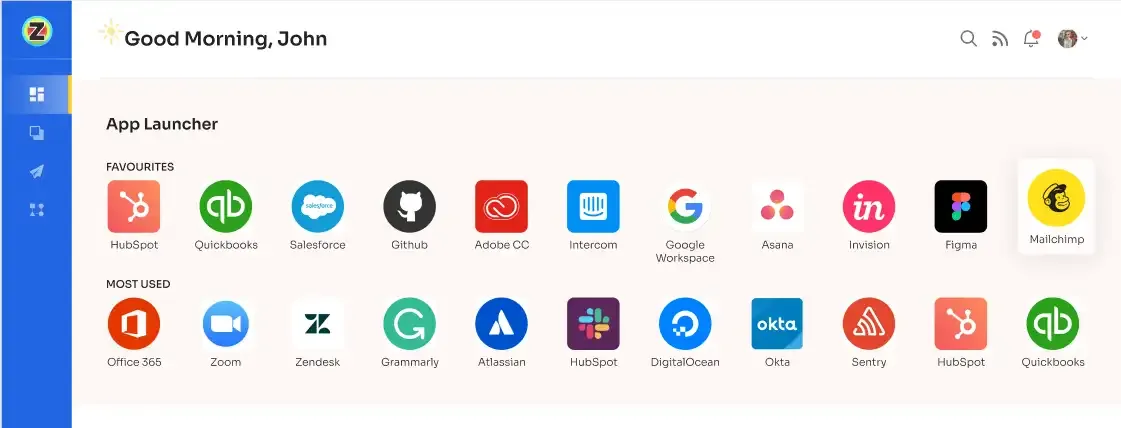
This innovative app store not only facilitates freedom of choice for employees but also ensures a secure environment under the vigilant oversight of the IT team. Through this platform, employees can freely explore and select applications while IT administrators adeptly monitor all activities, preempting security breaches and unauthorized usage.

Here's how it works:
- Zluri empowers IT administrators by offering comprehensive control over the types of apps displayed on the centralized dashboard. This control extends to managing different app categories, such as managed, unmanaged, or restricted, tailoring the experience to precise organizational requirements.
- Furthermore, administrators can fine-tune access to specific information within the app store, including compliance details, insights, security specifics, features, and recommendations. This meticulous control ensures that employees only encounter content relevant to their roles, maintaining focus and relevance.
- Moreover, Zluri equips IT administrators with precise view controls with it's intuitive dashboard, allowing them to regulate the visibility of app information accessible to employees, ensuring a streamlined and secure workflow.
- Automating offboarding workflow
Instances where departing employees retain access pose significant risks, such as potential data breaches due to unauthorized sharing or susceptibility to cyberattacks.
Zluri steps in to automate the access revocation process, playing a pivotal role in streamlining the offboarding procedure by swiftly terminating ex-employees' access to various SaaS applications. The platform offers a centralized control system that efficiently manages user access across multiple SaaS apps from a single hub, facilitating comprehensive oversight and control.
One of Zluri's standout features lies in its automated revocation capability. By implementing predefined workflows, Zluri ensures immediate and thorough removal of access privileges when an employee leaves the company. This automation eliminates the need for manual intervention, reducing the margin for error and ensuring a seamless transition in access removal procedures.
Moreover, Zluri provides the flexibility of customizable workflows, enabling tailoring to align with specific company policies and various role-based access requirements. This customization ensures that offboarding workflows accurately reflect different access levels within the organization, effectively mitigating security risks associated with access oversight.
Regarding compliance and security, Zluri aligns its access removal procedures with industry standards. By doing so, it not only minimizes the potential for data breaches but also ensures compliance with data protection regulations, thus fortifying the organization's security posture.
Step 1: From Zluri's main interface, select the “workflow module”. From there, choose "offboarding" from the drop-down menu and click on "New Workflow."

Step 2: Your team can select the users that they want to offboard by scrolling through the list or using the search bar. After selecting the users, click "Continue."

Step 3: Further, your IT admin can review all the applications accessible to the offboarded employees.
When your IT admin clicks on an application, they will see suggested actions under "recommended actions." Also, they can choose and perform the necessary actions for each selected application.

Step 4: Your team can either click on “run” to run the workflow or save the workflow by clicking on “save as playbook" for future use. This way, your team can easily refer to it whenever you need it.Moreover, as per KuppingerCole, automated onboarding/offboarding accelerates user lifecycle and saves hours of manual effort by your team.
- Other key features of Zluri that help with business process automation:
Zluri offers more than just streamlining onboarding and offboarding processes and other task management processes. Let's discover the other automated features it provides.
1. Automated SaaS Apps Discovery: Zluri employs a sophisticated methodology involving nine effective discovery techniques to automatically uncover all SaaS applications utilized within your organization. These methods encompass: MDMs, IDPs & SSO, direct integration with apps, finance & expense management systems, CASBs, HRMS, directories, desktop agents (optional), and browser extension (optional).
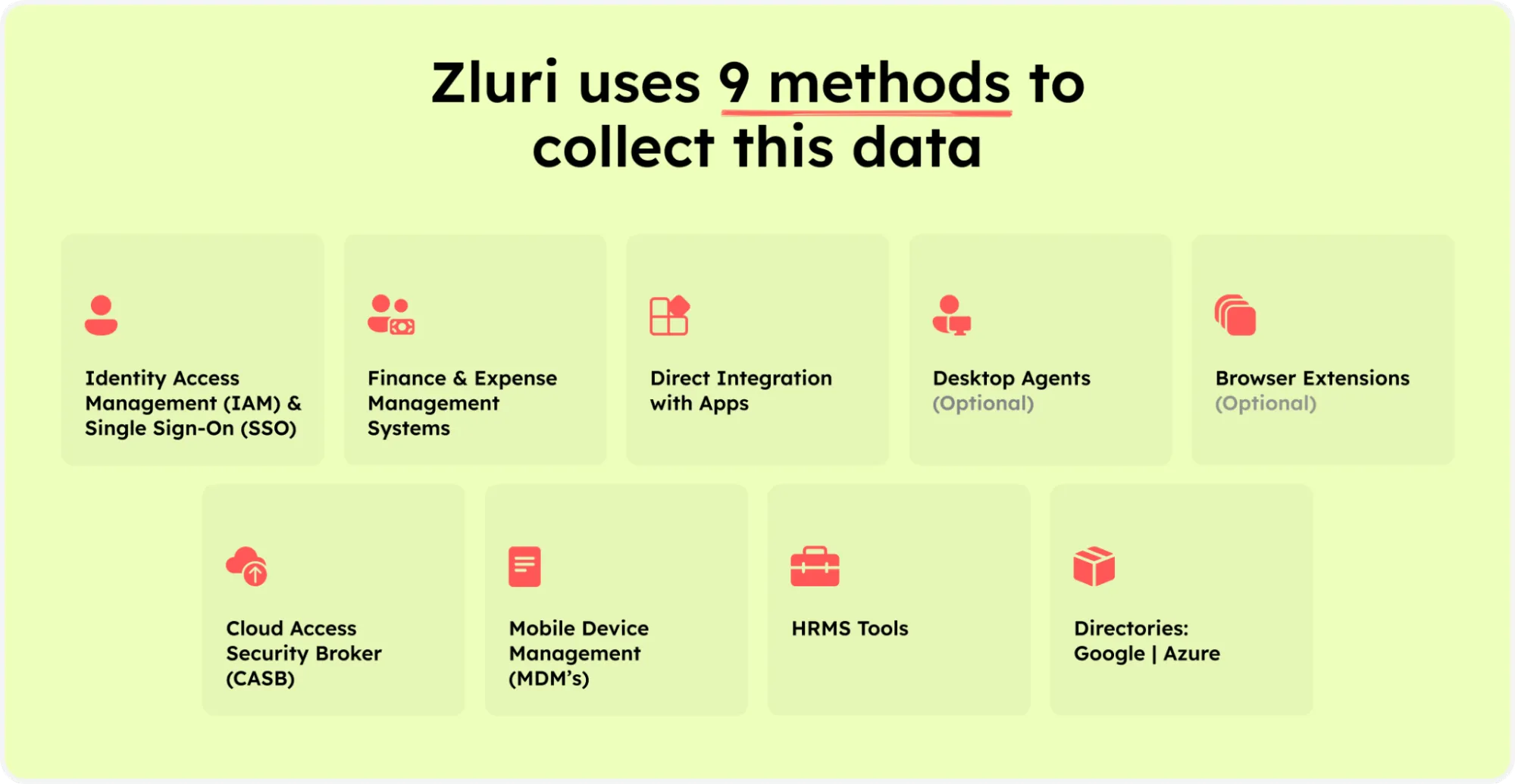
Zluri’s nine discovery methods
2. Automated SaaS Renewal Management: Zluri provides a proactive approach to managing upcoming SaaS renewals through its Renewal Calendar.
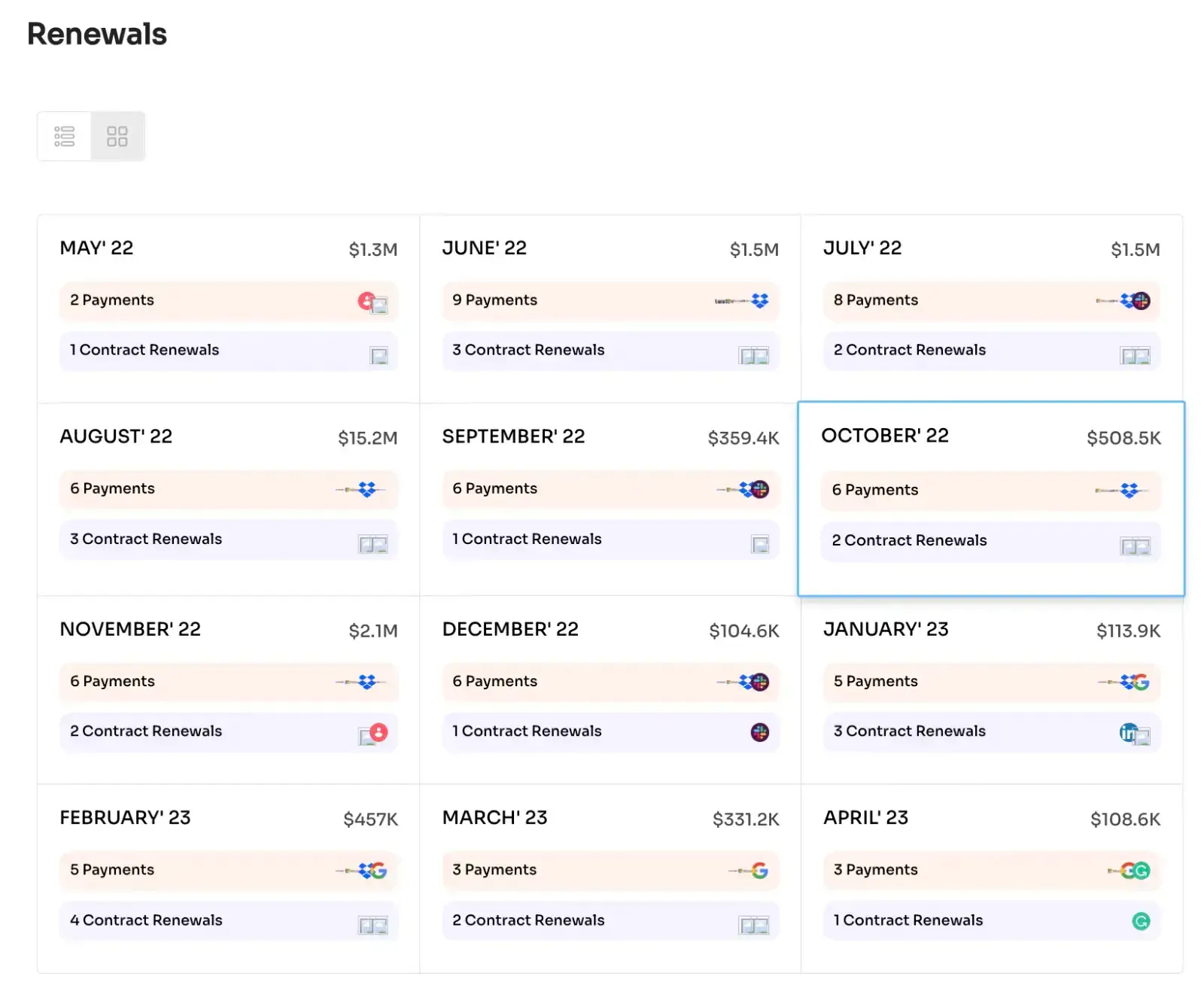
This comprehensive capability offers:
- Clear Insights: Detailed information and overviews of upcoming renewals, enabling proactive decision-making.
- Prioritization: Allows your team to prioritize renewals based on contractual value and expiration timeline.
- Preventing Missed Renewals: Ensures crucial renewals are never overlooked, minimizing disruptions.3. Automated SaaS License Management: Zluri simplifies the complexities of software license management by:
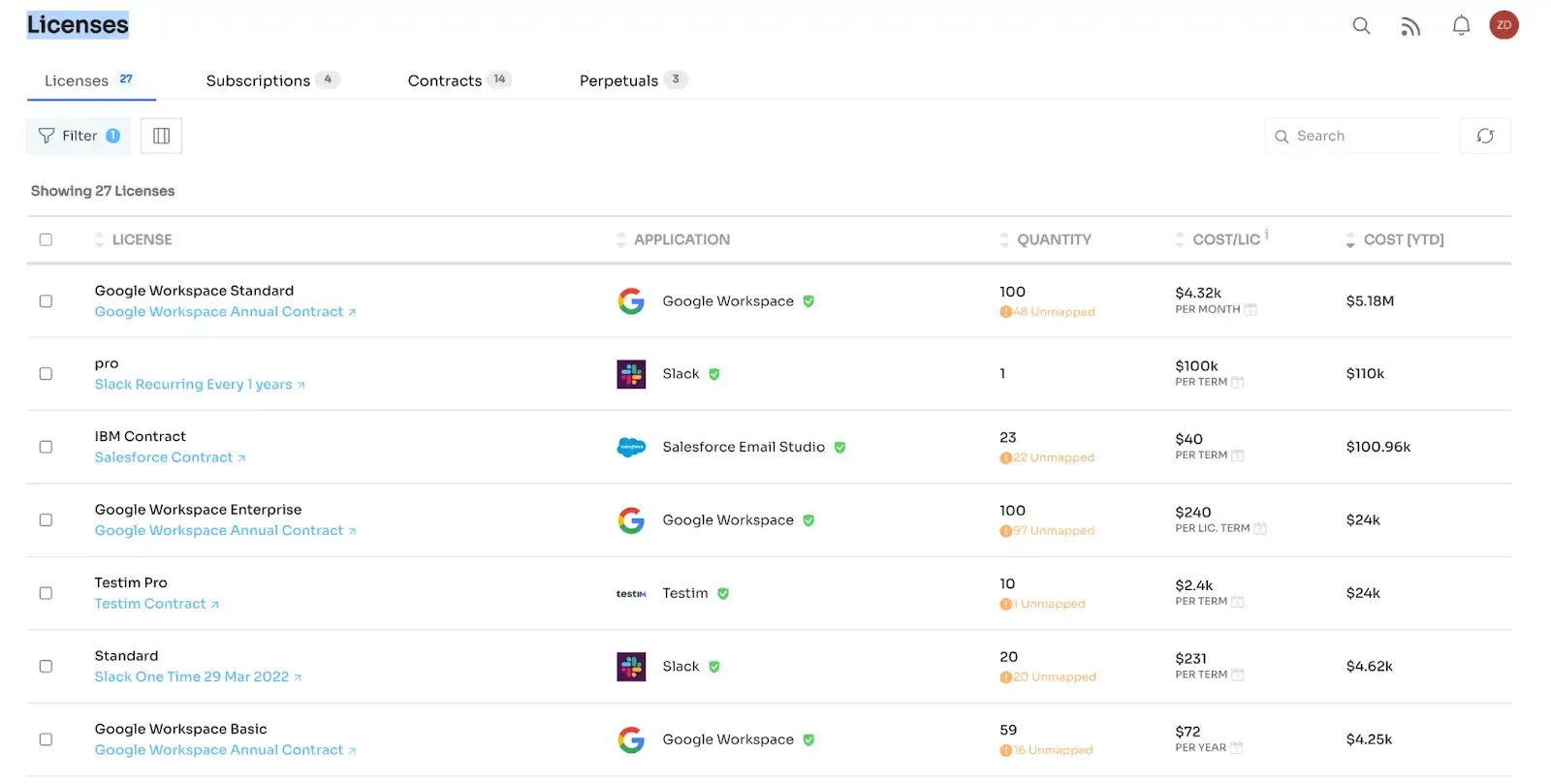
- Enhanced Efficiency: Streamlining workflow management related to software licenses, leading to increased operational efficiency.
- Cost Savings: Helping identify and manage unused or underutilized licenses to optimize spending.
- Compliance Assurance: Ensuring adherence to licensing agreements, mitigating compliance risks effortlessly.
4. Automated Vendor Management: Zluri's automation extends to efficiently managing the entire vendor lifecycle by:

- Eliminating Manual Tasks: Reducing administrative burdens through automated processes.
- Enhanced Efficiency: Allowing IT teams to focus on strategic initiatives by freeing them from routine vendor management tasks.
- Improved Oversight: Providing a centralized platform to track and manage vendor relationships seamlessly.
These comprehensive automated features offered by Zluri not only streamline specific operational aspects but also foster a more agile and efficient organizational ecosystem, enabling teams to focus on innovation and growth.
Request a demo today!
Pros
- Zluri offers over 300 API integrations, and you can easily add your own custom integrations to your system within just 36 hours.
- The platform allows you to set up conditional triggers that automate complicated IT processes. This saves your IT team valuable time and effort by eliminating manual tasks that can lead to errors.
- Zluri helps your team improve their overall efficiency by automating their regular tasks while also reducing costs and increasing revenue, eventually leading to better business outcomes.
- It provides a centralized location for all the business data, giving your IT teams better visibility of the company's performance and allowing them to make data-driven decisions.
Customer Rating
- G2: 4.8/5
- Capterra: 4.9/5
2. Kissflow

Kissflow is a business process management (BPM) software designed to empower your team with an intuitive platform to streamline and automate critical business processes. With its user-friendly interface and robust features, Kissflow helps optimize operations, enhance efficiency, and drive productivity.
Kissflow is an important option amongst Pipefy alternatives that simplifies workflow automation capabilities, allowing your IT team to effortlessly create, manage, and monitor complex processes. By replacing manual, time-consuming tasks with automated actions, Kissflow eliminates bottlenecks and reduces errors.
With Kissflow workflow, your IT admin can design custom workflows without any coding knowledge, ensuring a seamless transition from traditional processes to automated ones. This lets your team focus on high-value activities while Kissflow takes care of repetitive tasks, improving overall productivity.
Pros
- Kissflow offers your team an intuitive interface, enabling seamless integration with multiple tools for enhanced efficiency.
- This Pipefy competitor enables your teams to establish and tailor industry workflows efficiently according to their specific requirements.
Cons
- The tool can be challenging to set up and integrate with your organization's systems, resulting in your team needing to allocate additional time to automate the workflows.
- Kissflow may not be ideal for those seeking a highly adaptable and personalized automation tool. Its customization options are limited, potentially leading to inefficiencies in streamlining your organization's workflows.
Customer ratings
- G2: 4.3/5
- Capterra: 3.9/5
3. Workato

With Workato, your team can automate repetitive tasks and industry workflows, enabling them to focus on more strategic initiatives. This automation enhances operational efficiency and reduces human errors, improving the overall processes reliability of business processes.
This Pipefy alternative provides your team with robust capabilities for monitoring and managing business processes. With real-time visibility into workflows, they can identify bottlenecks, track performance, and make data-driven decisions to optimize processes continuously.
Pros
- The tool's exceptional flexibility enables continuous integration with any existing software in the market, allowing your IT team to automate IT processes efficiently.
- Workato's flexible nature enables customization of workflows, allowing tailored automation solutions that precisely fit your organization's unique needs, leading to optimized processes.
Cons
- This may not be the best choice if you seek a cost-effective solution. The pricing of this tool depends on the number of automation rules you require to perform various tasks. For instance, if your team wants to automate a simple task that isn't performed frequently, you may incur an additional charge.
- Your team may need to invest additional time in reducing the file size before importing documents due to the tool's limitations on document size
Customer ratings
- G2: 4.7/5
4. MuleSoft

The MuleSoft platform empowers your IT team to streamline business process management and achieve operational excellence. With its seamless integration capability, efficient business process automation, robust API management, and centralized data governance, MuleSoft enables you to enhance collaboration, drive efficiency, and deliver exceptional customer experiences.
MuleSoft is another notable one of Pipefy alternatives that provides an advanced platform for automating business processes, reducing manual effort, and increasing operational efficiency. Through MuleSoft's intuitive visual interface, your IT teams can design workflow automation capabilities by connecting mobile applications, data sources, and APIs.
Pros
- MuleSoft offers an intuitive platform, making it easy for teams to set up and navigate. This user-friendly interface simplifies the process of automating workflows, enabling efficient optimization of IT operations.
- The platform offers robust API management and centralized data governance, ensuring data flows securely and consistently across the organization.
Cons
- While considering this solution, it's important to note that it may not be the most suitable choice if you have limited financial resources. The pricing of this solution surpasses that of any other tools, rendering it a costly option to take into account
- Integrating multiple systems, such as cloud applications, with this tool can pose a complexity challenge. This limitation hinders your team's ability to automate task management processes and effectively manage IT processes
Customer ratings
- G2: 4.4/5
- Capterra: 4/5
5. Zapier

Zapier is a central hub connecting various web applications, allowing seamless data transfer and automation between them. Zapier boasts an impressive library of over 3,000 integrations, covering many popular business applications.
One of the key strengths of Zapier is its ability to automate repetitive tasks and streamline complex workflows. Your IT team can create" Zap, " an automated industry workflow triggered by predefined events or actions. These Zaps eliminate the need for manual data entry, allowing teams to focus on more strategic initiatives.
With Zapier, your IT admin can automate task management processes like lead generation, data synchronization, custom report generation, and much more, improving overall operational efficiency. Its user-friendly interface allows for easy configuration and customization of triggers, actions, and filters.
Pros
- With this Pipefy competitor, your IT teams can effortlessly add new tools not already available in the library. This allows them to automate their IT processes with ease and efficiency.
- The tool offers powerful features, such as triggers, which enable your IT teams to seamlessly connect and integrate with multiple systems.
Cons
- The inefficiency of the tool's user interface poses difficulties for your team when it comes to optimizing IT processes. This delay uses valuable time that could have been dedicated to more important tasks.
- Although Zapier offers a free plan, it only supports basic integrations. If you need advanced integration capabilities, you will have to choose the paid plan, which is slightly more expensive. If budget is a concern, then this may not be a suitable option.
Customer ratings
- G2: 4.5/5
- Capterra: 4.7/5
6. Boomi
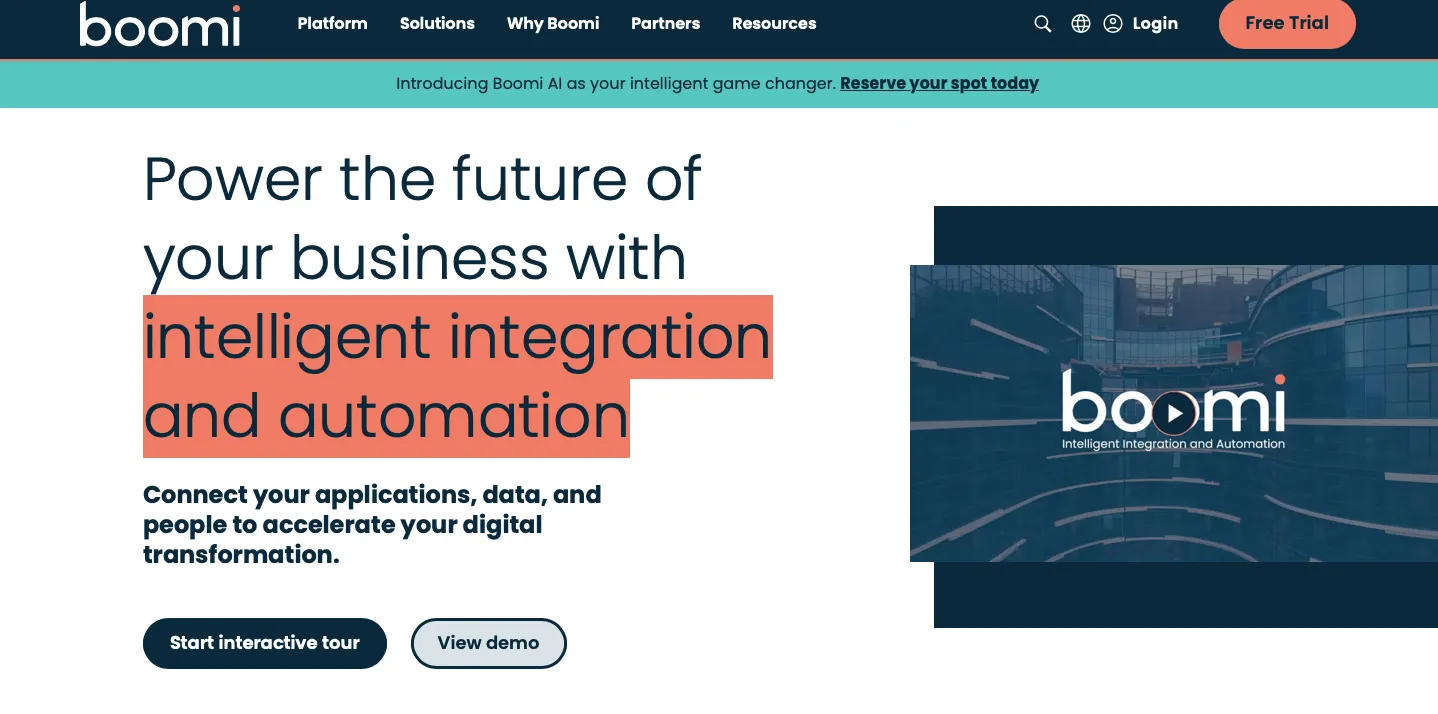
Boomi offers a comprehensive suite of features to simplify and automate business process management. With Boomi, your team can effortlessly map, orchestrate, and streamline industry workflows across business applications, systems, and data sources.
Moreover, this crucial tool from Pipefy alternatives allows your IT admin to connect disparate systems, applications, and databases, whether on-premises, cloud, or hybrid. Boomi empowers you to achieve expedited and dependable integrations, increasing efficiency and productivity.
Whether managing employee information, automating IT processes, or synchronizing data between various departments, Boomi provides a centralized platform to simplify complex business processes.
Pros
- If you're working with a limited budget, this solution is an excellent option because it provides affordable pricing plans that include integration capabilities and other valuable features
- The tool seamlessly integrates with various systems, allowing your team to easily automate processes for improved efficiency
Cons
- If you're seeking a user-friendly platform for your team, this solution might not be the most suitable option, as it includes advanced features that can be challenging for them to understand and navigate
- Instead of facilitating your team's ability to filter specific data, this tool obstructs their progress by imposing the need for additional information during the filtering process. It significantly hampers your team's efficiency in effective task management, leading to notable delays
Customer ratings
- G2: 4.3/5
- Capterra: 4.4/5
7. Nintex Process Platform
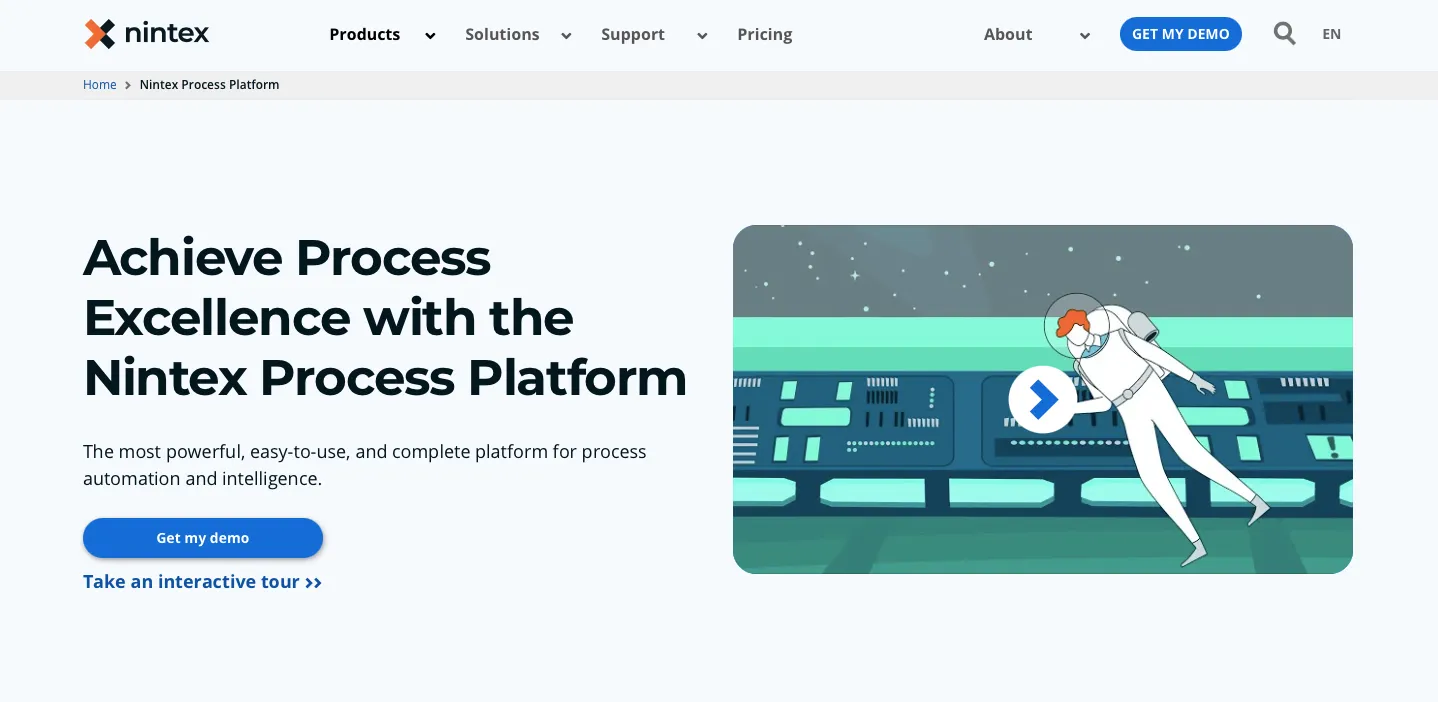
The Nintex process platform simplifies and automates workflows, allowing you to optimize business processes. With its intuitive drag-and-drop interface and visual workflow designer, your IT admin can easily map out processes, define rules, and automate routine tasks.
Also, with Nintex, your team can seamlessly connect the platform with existing systems, business applications, and data sources, whether they are on-premises, cloud, or hybrid. The platform's robust integration capabilities enable data exchange in real-time, ensuring synchronized information across different systems.
Pros
- Its intuitive drag-and-drop interface and visual workflow designer make it accessible even for non-technical users, empowering them to create and manage workflows without extensive coding knowledge.
- Nintex easily integrates with various existing systems, applications, and data sources, whether on-premises, cloud-based, or hybrid, ensuring smooth connectivity and data exchange across different platforms.
Cons
- It has a steep learning curve, requiring you and your team to invest more time to learn and use the management workflows at their full potential
- If you are seeking a cost-effective option to generate intricate workflows, then this solution falls short as it is characterized by high expenses and an inability to meet your industry workflow requirements effectively
Customer ratings
- G2: 4.2/5
- Capterra: 4.1/5
8. ProcessMaker

ProcessMaker is one of the most notable Pipefy alternatives that offers a comprehensive solution for mapping, automating, and optimizing business processes. By automating routine tasks and reducing manual intervention, ProcessMaker eliminates errors, reduces operational costs, and accelerates process execution.
ProcessMaker also seamlessly integrates with your existing systems, databases, and third-party applications, providing your team with a unified platform to manage and monitor processes. It allows easy integration with CRM, ERP, and other enterprise systems, ensuring data synchronization and reducing silos.
Additionally, ProcessMaker promotes collaboration among team members by enabling real-time communication, document sharing, and task assignments, fostering a culture of transparency and accountability.
Pros
- This Pipefy alternative is ideal for enhancing the efficiency of non-technical users in workflow automation, enabling effective automation regardless of technical background.
- It offers affordability with pricing plans inclusive of integrations and automation features, making it a budget-friendly option for organizations with financial constraints.
Cons
- If your organization is large and relies on multiple variables for its IT processes, this solution may not be suitable as it struggles to simplify complex processes effectively.
- The platform might lack extensive customization options for highly specialized or unique workflows. Organizations requiring highly tailored or niche processes may find the tool's customization capabilities somewhat restrictive.
Customer ratings
- G2: 4.3/5
- Capterra: 4.5/5
9. Appian
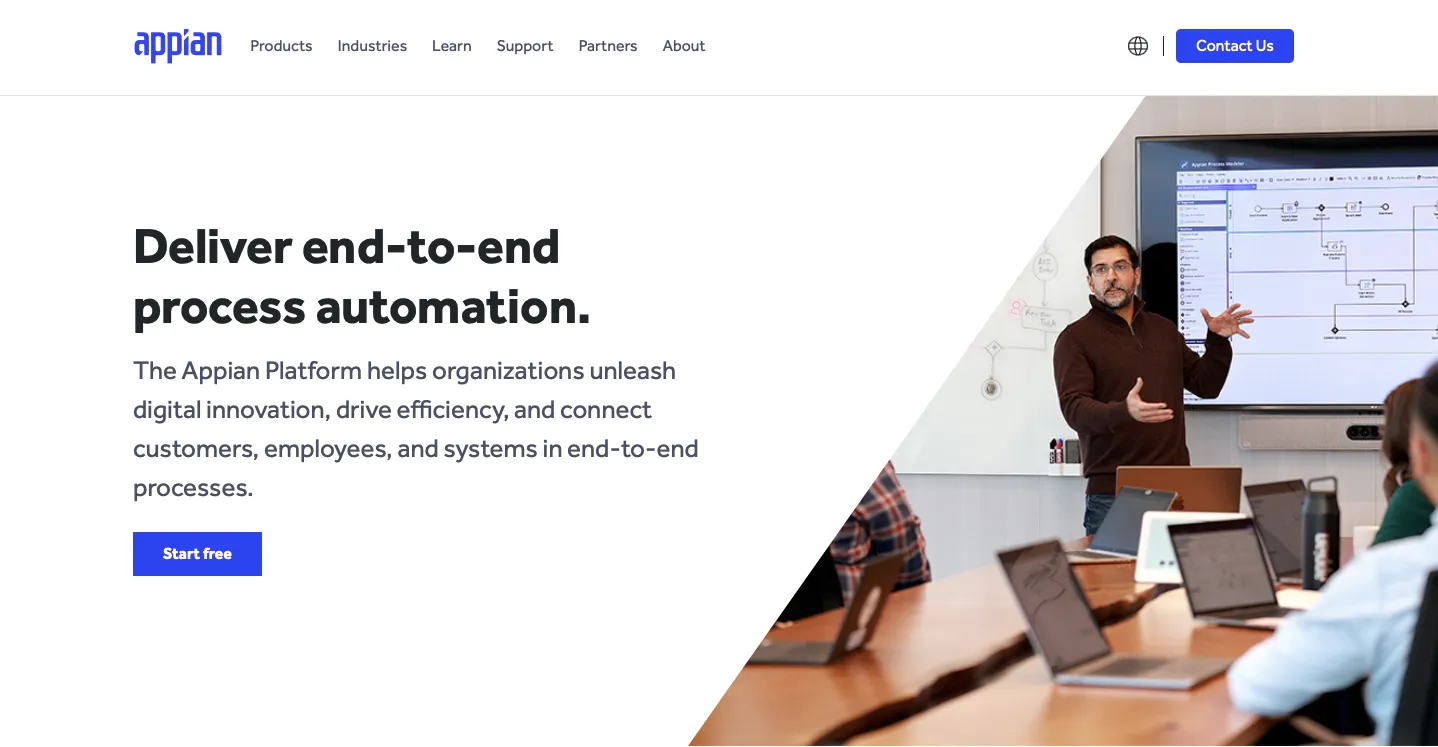
Appian stands out in the market due to its unique low-code automation capabilities. This low-code approach accelerates development cycles, reduces reliance on specialized technical skills, and empowers your team to respond rapidly to changing business requirements.
With Appian, your team can seamlessly integrate data, systems, and business applications from various sources, both on-premises and in the cloud. This unified view lets you gain real-time insights into end-to-end processes, identify bottlenecks, and drive continuous improvement. Appian's BPM solution leverages artificial intelligence (AI) and machine learning (ML) capabilities to unlock valuable insights from your organization's data. By applying advanced analytics and predictive modeling, IT managers can gain deeper visibility into process performance, identify patterns, and proactively address potential issues.
With Appian's AI-driven decision support, your team can automate routine tasks, reduce manual errors, and allocate resources more efficiently, allowing your team to focus on higher-value activities.
Pros
- The tool offers a user-friendly interface that simplifies the task management processes of designing and managing industry workflow processes for your teams.
- The tool offers seamless integration with your organization's existing apps, enabling your team to enhance productivity through IT process automation and facilitating streamlined operations.
Cons
- The tool may not provide as robust analytics and reporting features as other BPM tools, restricting your team's ability to gather the necessary insights for making informed decisions.
Customer ratings
- G2: 4.5/5
- Capterra: 4.2/5
10. Studio Creatio

StudioCreatio's advanced process automation functionality allows your teams to automate repetitive and time-consuming tasks. With its easy-to-use visual process designer, they can build and deploy workflow automation capabilities without the need for extensive coding knowledge.
This crucial software from the Pipefy alternatives list also provides you with real-time visibility into your business processes through its comprehensive monitoring and analytics capabilities. The software captures valuable data points and generates in-depth reports.
Your IT team can track process performance, identify bottlenecks, and measure key performance indicators (KPIs) to make data-driven decisions. This allows for continuous process optimization and proactively addressing any inefficiencies.
Pros
- The tool's powerful integration capabilities enable your team to seamlessly automate IT processes, harnessing its ability to create and process data from various sources.
- It provides comprehensive monitoring and analytics, offering real-time insights into business processes. This visibility helps in understanding performance and identifying areas for improvement.
Cons
- The tool might not be very user-friendly, particularly for those without extensive technical knowledge, potentially creating a learning curve. This complexity could hinder the streamlining of IT processes and consume more time.
- Due to its complexity, there's a risk that teams might spend more time learning the tool than utilizing it effectively for critical tasks, potentially leading to inefficiencies in the short term.
Customer ratings
- G2: 4.9/5
- Capterra: 4.8/5
11. Oracle BPM Suite

Oracle BPM suite offers an intuitive process design interface, allowing your team to model and map out the organization's workflows effortlessly. With this, your IT admin can easily define process steps, rules, and conditions to create visually appealing process diagrams.
This simplifies the process modeling experience, clearly representing how various tasks and activities connect, making it easier to identify areas for optimization and improvement.
Moreover, this Pipefy alterntaive enables your IT team to automate repetitive and time-consuming tasks through its advanced process automation capabilities, like user provisioning and deprovisioning.
Pros
- Oracle BPM offers an intuitive interface that simplifies process design. This allows teams to easily model and map out workflows, enhancing the visualization of organizational processes.
- Oracle BPM offers advanced automation capabilities, allowing the automation of repetitive and time-consuming tasks. This includes functionalities like user provisioning and deprovisioning, which can significantly enhance efficiency.
Cons
- It necessitates frequent password changes for both your team and the end user. This can pose a challenge for effectively utilizing the tool to automate IT processes.
Customer ratings
- G2: 4/5
Embracing Tailored Business Process Solutions for Sustained Business Growth
The diversity and innovation among Pipefy alternatives enable businesses to find tailored solutions that amplify productivity, efficiency, and adaptability. The key lies in a meticulous assessment of individual business needs against the features and capabilities offered by each platform, ensuring a seamless integration that elevates operational excellence.
The landscape will continue to evolve, and new innovations will emerge, offering businesses even more tailored and potent solutions. The roadmap to success involves leveraging these Pipefy alternatives' strengths to streamline operations, enhance productivity, and drive sustained growth in an increasingly competitive landscape.
FAQs
1. What are the key factors to consider when choosing Pipefy alternatives?
Consider scalability, ease of use, integration capabilities, customization options, pricing, and customer support as crucial factors. Assess how well a platform aligns with your unique business requirements.
2. Are these Pipefy alternatives suitable for small businesses or larger enterprises?
The listed alternatives cater to a wide spectrum of businesses, from startups to large enterprises. Each offers scalable solutions, allowing customization to suit the needs of various company sizes.
3. Can these Pipefy alternatives seamlessly integrate with existing software and tools?
Yes, most alternatives emphasize integration capabilities, offering connections with a wide array of applications to streamline workflows and enhance productivity.









.svg)














